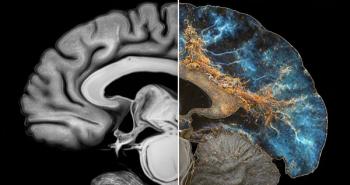
Pill Impaction Mimicking Appendicitis in HIV-Positive Patient
A 45-year-old Hispanic man who acquired HIV infection in April 2003 presented with a 24-hour history of worsening right lower quadrant pain accompanied by fever, decreased appetite, nausea, and vomiting. The pain was described as sharp, constant, and nonradiating. He denied any accompanying diarrhea, constipation, urinary frequency, dysuria, dyspepsia, reflux symptoms, or previous episodes of abdominal pain. There was no history of recent travel. His current CD4+ cell count was 239/?L. In May 2003, he had a CD4+ cell count nadir of 133/?L. His HIV RNA level has remained undetectable at less than 50 copies/mL since starting firstline antiretroviral therapy in June 2003. Therapy consists of coformulated zidovudine/lamivudine/abacavir and efavirenz. He has never had opportunistic infections or other major medical illnesses.
A 45-year-old Hispanic man who acquired HIV infection in April 2003 presented with a 24-hour history of worsening right lower quadrant pain accompanied by fever, decreased appetite, nausea, and vomiting. The pain was described as sharp, constant, and nonradiating. He denied any accompanying diarrhea, constipation, urinary frequency, dysuria, dyspepsia, reflux symptoms, or previous episodes of abdominal pain. There was no history of recent travel. His current CD4+ cell count was 239/?L. In May 2003, he had a CD4+ cell count nadir of 133/?L. His HIV RNA level has remained undetectable at less than 50 copies/mL since starting firstline antiretroviral therapy in June 2003. Therapy consists of coformulated zidovudine/lamivudine/abacavir and efavirenz. He has never had opportunistic infections or other major medical illnesses.
Physical examination revealed a temperature of 38.2C (101F); pulse rate, 106 beats per minute; 10 out of 10 tenderness over the right lower quadrant with muscle guarding; and positive Rovsing, obturator, and psoas signs. Rectal examination showed tenderness over the right rectal vault.
Laboratory analysis demonstrated a white blood cell count of 13 106/L(76% neutrophils). Findings from urinalysis were normal. Findings on a CT scan of the abdomen with contrast were normal with no evidence of appendicitis. Because of persistent abdominal pain with normal findings on the CT scan of the abdomen, colonoscopy was performed. Figures 1, 2, and 3 are images taken at the level of the terminal ileum. Figure 1 shows an impacted pill in the appendiceal orifice. Figure 2 shows the removal of the pill using forceps. Figure 3 shows mild residual inflammation of the appendiceal orifice after removal of the impacted pill.
Figure 1
Figure 2
Figure 3
Discussion
Abdominal pain is a frequent presenting symptom among HIV-positive patients seeking care at emergency departments. The incidence is estimated to be 12% to 45%.
1
In one retrospective study conducted in 1997 at San Francisco General Hospital, abdominal pain was the sole complaint in 18% of the patients.
1
The majority, however, reported other accompanying symptoms. The most common were nausea/vomiting (58%), diarrhea (32%), and fever (21%).
Evaluation of the cause of abdominal pain rests on thorough history taking and physical examination. The differential diagnosis of right lower quadrant pain in a non-immuno compromised, HIV-negative patient includes appendicitis; diverticular disease and its complications; intra-abdominal abscesses; kidney stones; sexually transmitted diseases; enterocolitis; and intestinal obstruction from mechanical causes, such as strictures, masses, volvulus, and intussusception.
The differential diagnosis of right lower quadrant pain among HIV-positive patients also includes malignancies, such as lymphoma and Kaposi sarcoma, and opportunistic infections, such as those caused by mycobacteria (ie, Mycobacterium tuberculosis and Mycobacterium avium-intracellulare) and cytomegalovirus. Immune reconstitution syndrome associated with recent introduction of antiretroviral therapy also may produce atypical presentations of disease. The list of differential diagnoses becomes more lengthy and complex as the CD4+ cell count declines.
Workup of abdominal pain in a patient with HIV infection is the same as that for the noninfected patient.2 However, because of the vast differential diagnoses, the probability of coexisting conditions caused by multiple pathogens,3 and atypical presentations of common disorders, 4 radiological imaging such as CT and abdominal sonography should be used early in the assessment of abdominal pain in HIV-positive patients.2
Normal findings on a CT scan of the abdomen may lead the clinician to consider endoscopic procedures (ie, esophagogastroduodenoscopy or colonoscopy). Colonoscopy, in this case, served both diagnostic and therapeutic purposes.
Pill impaction that causes inflammation in the intestinal mucosa is an unusual cause of abdominal pain. The impacted pill was removed endoscopically. The patient was given metoclopramide, a prokinetic agent, for a week. Pill impaction has not recurred. To our knowledge, this is the first reported case of pill impaction presenting clinically as an appendicitis mimic in a patient who is HIV-positive.
It is unknown what causes pill impaction among HIV positive patients. Varying degrees of enteropathy develop in HIV-infected patients, especially those who have advanced disease. AIDS patients have been shown to have delayed gastric emptying5 with impairment of both intestinal absorption and permeability,6 factors that may promote pill impaction with resulting local mucosal inflammation. None of the medications that are used to treat HIV infection have been shown to significantly affect intestinal function (absorption, permeability, and inflammation) or alter intestinal transit times.5
Recurrent pill impaction should warrant manometric studies with or without gastric or small-intestine biopsies to determine the cause and appropriate treatment. Prokinetic agents, such as metoclopramide and erythromycin, and also octreotide provide short-term, symptomatic relief.
References:
- Yoshida D, Caruso JM. Abdominal pain in the HIV infected patient. J Emerg Med. 2002;23:111-116.
- Wilcox CM, Friedman SL. Gastrointestinal manifestations of the acquired immunodeficiency syndrome. In: Feldman M, Sleisenger MH, Scharschmidt BF, eds. Sleisenger & Fordtran’s Gastrointestinal and Liver Disease. 6th ed. Philadelphia: WB Saunders; 1998:387-409.
- Slaven EM, Lopez F, Weintraub SL, et al. The AIDS patient with abdominal pain: a new challenge for the emergency physician. Emerg Med Clin North Am. 2003;21:987-1015.
- 4. Kuhlman JE, Fishman EK. Acute abdomen in AIDS: CT diagnosis and triage. Radiographics. 1990;10:621-634.
- Sharpstone D, Neild P, Crane R, et al. Small intestinal transit, absorption, and permeability in patients with AIDS with and without diarrhoea. Gut. 1999;45:70-76.
- Bjarnason I, Sharpstone DR, Francis N, et al. Intestinal inflammation, ileal structure and function in HIV. AIDS. 1996;10:1385-1391.
Newsletter
Enhance your clinical practice with the Patient Care newsletter, offering the latest evidence-based guidelines, diagnostic insights, and treatment strategies for primary care physicians.



























































































































































































































































































